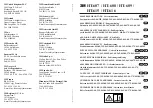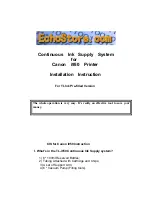
a.
Disconnect R l and connect the emitters of Q3 and Q4 with
the output terminal via two resistors as illustrated in Fig. 2.
Their resistance should be a b o u t a half of R l . Low
resistance will allow excessive current in Q3 and Q4 and
will damage them. High resistance will decrease the out
p u t . Their rated power is a b o u t 1/4 W .
Driver stage Power stage
Output
Fig. 2 Circuit (c) — Grounding Emitters
The function of R l
In the circuit (c) R l inserted between the emitters of Q3
and Q4 is for maintaining idle current in Q3 and Q4 to
avoid non-linear range of transistor amplification charac
teristic.
The current has been m a d e about 5—10mA. In Fig. 4,
when the potential difference between T P 1 and T P 2 is set
to 60mV, Q F s collector current becomes 136mA.
Q P s Hfe is 110. Then the base current becomes 1.23mA.
To flow 5 m A current in Q 3 , the current from (A) to ( § )
should be 3.8mA. T o m a k e a current of 3.8mA in R l , the
potential difference between (A) and ( § ) should be 1.26V
(0.6 + 0.06 + 0.6). So R l should be 330 O .
b .
Insert diodes in place of power transistors as shown in
Fig. 3. Leave R l connected.
Use powerful rectifying diodes used in mains current rec
tifier or open the output load before checking the circuit
because the current in the diodes becomes larger than one
ampere when an input signal is applied although the cur
rent is negligibly small when no signal is applied.
Diodes' polarities should also be verified to avoid damag
ing them.
Driver stage Power stage
Output
Fig. 3 Circuit (c) — Inseting Diodes
Driver stage Power stage
Output
Fig. 4 Circuit (c) — Emitters Floating
22
Cut
Cut
Cut
Cut
+B
- B
Cut
Cut
+B
Cut
Cut
- B
136 mA
1.23 mA
5.03 mA
3.8 mA
TP1
0.06V
TP2
+B
- B
R1
330
0.22^
0.22
R1
Q3,
Q1
Q4
Q2
R1
Cut
1/2R1
1/2R1
Q3
Q1
Q4
Q2
Q3
Q1
Q4
Q2
















































